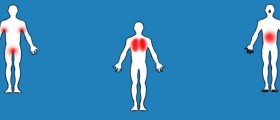
Plague is an infectious bacterial disease that may sometimes cause lethal outcome. In the Middle Ages the infection was referred to as 'Black Death' and was blamed for death of more than one-third of people living in Europe. Today thanks to antibiotics plague is treatable. Only in less developed countries of the world death may affect patients due to inappropriate medical care.
Plague is Caused by Bacteria
As it has already been mentioned plague is bacterial infection. The infectious agent responsible for all the symptoms and signs of the disease is a facultative anaerobic, Gram-negative, intracellular bacteria called Yersinia pestis.
This infectious agent is transmitted from a host to humans via the bite of a vector. In this case the vector is a flea. It is also possible to contract the infection if there is a close contact with infected tissues/bodily fluids. Inhalation of aerosolized bacteria is another way of introduction of the microorganism into one's body. The most common way of contracting Yersinia pestis is by being bitten by infected fleas. Fleas normally infest rodents, so in areas where rodents, especially rats breed uncontrollably the risk of plague is much higher. What is more, other rodents such as kangaroo roots, deer mice, grasshopper mice and voles are all potential vectors of fleas and carriers of bacteria blamed for plague.
The rat flea is a well-known vector of Yersinia pestis. There are 30 different flea species all of which are capable of transferring the harmful bacteria. Apart from fleas Yersinia pestis may be transmitted via tick bites and human lice.
Plague bacteria are rather resistant. Even when their host dies, they may survive dormant in soil, grains and dried sputum, representing a potential source of infection.
Once the bacteria enter the body patients may develop a range of symptoms depending on the type of plague. Namely, in case of bubonic plague symptoms occur 1-7 day after the bacteria have entered the body via the skin while pneumonic and septicemia plague both develop much quicker, only after 1-4 days after inhaling aerosolized bacteria.
Difference in Pneumonic and Bubonic Plague
Even though in the majority of cases patients develop either bubonic or pneumonic plagues, there is one more form of the disease that should never be neglected called septicemia plague.
It is estimated that bubonic plague occurs most frequently affecting approximately 80-95% of all patients. Bubonic plague develops as a result of flea bites or bites of other vectors such as human lice or ticks. Infected fleas contain bacteria in their esophagus. This prevents food from reaching their stomach. Once these pests come in contact with their food source starved fleas start to suck human blood rapidly and while trying to swallow the blood their esophagus recoils allowing the bacteria to enter the skin of the bitten person.
Once the infectious agents enter the skin and blood stream, they travel to regional lymph nodes, predominantly these in the groin, neck or armpit areas. They start to multiply there triggering lymph node enlargement. Such enlarged lymph nodes are known as buboes. Apart from being enlarged the affected lymph nodes eventually become necrotic and start to bleed. From there the bacteria may seed further affecting distant organs such as the lungs, liver, spleen, kidneys and in rare cases the membrane surrounding the brain. Bubonic plague is highly lethal and may cause death in 50-60% of people who receive no treatment.
Another form of plague is pneumonic plague. This is a severe infection developing once the person introduces the bacteria into the body through the respiratory tract. The bacteria enters the lungs and starts to multiply uncontrollably triggering pneumonia. Pneumonic plague is also possible to occur if there is widespread dissemination of Yersinia pestis from the previously affected lymph nodes of the groin or armpit area. Left untreated, pneumonic plague soon progresses into sepsis.
Septicemic plague is a complication of systemic bacterial dissemination. Both bubonic and pneumonic plague may progress and cause sepsis and potential lethal outcome.
Due to all the mentioned we can conclude that plague is a serious medical condition that requires proper treatment. Diagnosis is easily made thanks to growing the bacteria from samples of sputum, blood, infected lymph nodes or spinal fluid. It is also possible to perform testing of specific antibodies. However, since the results of such tests are not immediately available treatment starts soon after physical examination when doctors still suspect the patient is suffering from plague.
Yersinia pestis can be successfully eradicated with a number of available antibiotics. These include streptomycin and gentamicin (both members of aminoglycosides) as well as tetracyclines and fluoroquinolone Ciprofloxacin. The course of antibiotics generally lasts for 10 days. Antibiotic treatment must start within 24 hours after the onset of symptoms. Patients may additionally require oxygen, intravenous fluid and sometimes even respiratory support which depends on the type of plague and severity of the infection.
Finally, people who are traveling to endemic countries receive antibiotics prophylactically and they are advised to avoid being bitten by fleas and abstain from any contact with potentially infected animals and people that may be suffering from plague.












-Arthritis_f_280x120.jpg)




Your thoughts on this
Loading...